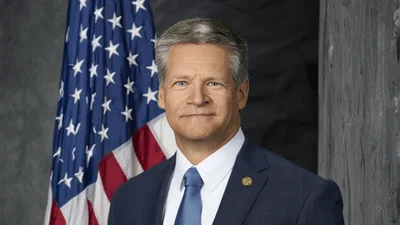WASHINGTON, DC - House Energy and Commerce Committee Chairman Fred Upton and Oversight and Investigations Subcommittee Chairman Cliff Stearns are pressing Energy Secretary Steven Chu for answers regarding a $1.4 billion partial loan guarantee for a large-scale rooftop solar project that was to be supplied equipment by Solyndra. Documents gathered during the investigation have raised questions about DOE’s approval of a conditional commitment to Prologis while Solyndra’s financial condition deteriorated. The documents reveal that Solyndra’s involvement in Prologis’ Project Amp was a significant factor both in the negotiations between DOE and Solyndra relating to a possible second restructuring of the loan guarantee in August 2011 and in the closing of the Project Amp loan guarantee. Committee leaders are seeking information about the relationship between Prologis and Solyndra and the reasons behind Secretary Chu’s personal intervention.
The multi-phase, multi-state installation of approximately 733MW of photovoltaic solar panels on commercial facility rooftops owned by Prologis received a conditional commitment from DOE in June 2011, at a time when Solyndra’s financial condition was quickly deteriorating. During the month of May 2011, DOE officials had discussions about a potential Solyndra bankruptcy, and whether it was possible for DOE to initiate an involuntary bankruptcy of the company. In June, Solyndra reached an agreement with Argonaut, under which Argonaut would purchase the company’s Accounts Receivable so that cash could be immediately injected into the company. Although Solyndra announced bankruptcy in late August, DOE finalized the Prologis loan guarantee on Sept. 30, 2011.
May 6, 2011, Credit Paper Submitted to DOE Identifies Solyndra as Sole Supplier for First Phase of Project Amp
In the letter to Secretary Chu, the Committee leaders write, “According to the May 6, 2011, Credit Paper that was submitted to the DOE Credit Review Board that approved the conditional commitment for Project Amp, the solar panels for the first phase of Project Amp, referred to elsewhere as “˜Project Photon,’ were to be supplied solely by Solyndra, Inc. (Solyndra). The remaining phases of the project had not been defined at the time the Credit Paper was submitted to the DOE Credit Review Board (CRB). That being said, “˜Basic Phase Parameters’ for the project had been established, and the Credit Paper stated that Solyndra’s inclusion was an “˜exception’ to the criteria relating to “˜supplier financial strength.’ The Credit Paper went on to state that the Loan Programs Office believed, however, that Project Amp was “˜adequately insulated from the risks associated with the long-term financial health of Solyndra.’ Less than four months after the Credit Paper was drafted, Solyndra filed for Chapter 11 bankruptcy."
In Mid-June, With Solyndra Stakes Running High, Documents Indicate Secretary Chu Personally Intervened in Project Amp
The Committee leaders continued, “Documents produced to the Committee during the course of its investigation of the DOE Loan Guarantee Program indicate that there may have been some hesitation on the part of DOE with respect to issuing a conditional commitment for the Project Amp loan guarantee. In a June 17, 2011, email, a Solyndra employee shared what he had learned from a BAML senior investment banker who took part in the Project Amp negotiations with DOE, stating that, “˜[O]n three occasions this week he thought that the [Project Amp] deal was dead, but Secretary Chu personally pulled it off. Chu shared with the team that this deal went to higher levels in the Obama Administration to gain approval than any other transaction in the Loan Guarantee Program, and that he personally committed to seeing it through to a successful conclusion.’ Further, the minutes of the June 18, 2011, meeting of the DOE Credit Review Board for Project Amp stated that “˜Secretary Chu had requested the CRB convene to consider Project Amp.’ The Committee staff have reviewed the Credit Review Board meeting minutes for all Section 1705 loan guarantee applicants during an in camera review. Only the Credit Review Board minutes for Project Amp reference any involvement by the Secretary."
In Mid-August, Project Amp Was a Critical Component of DOE’s Consideration of Second Restructuring of Solyndra Loan
The Committee leaders write, “In mid-August 2011, DOE was urging Argonaut Ventures, Inc. (Argonaut), Solyndra’s largest investor, to inject additional money into the company so that it could stay in business while DOE and Solyndra determined if there was a way to restructure the company for a second time. While these discussions took place, Solyndra was also negotiating with Prologis the terms of the agreement to supply panels for Project Photon, the first phase of Project Amp. The Project Photon agreement was critical for Solyndra as it struggled to improve its financial condition after the first restructuring. According to Solyndra’s estimates, finalizing the sales contract would have allowed Solyndra to meet its sales projections for the second half of 2011."
Upton and Stearns continued, “On Aug. 26, 2011, a senior Argonaut advisor emailed other Argonaut colleagues and stated that further investment in the company was “˜dependent on the ProLogis [sic] order coming in which has still not been finalized.’ The senior Argonaut advisor went on to explain that DOE might not continue to fund Solyndra’s loan guarantee, even if the ProLogis [sic] deal was finalized, unless Solyndra’s investors made a “˜broader commitment to fund the company going forward.’ Another Argonaut official responded and asked whether “˜DOE [would] put pressure on Prologis to sign?’ Other documents produced to the Committee appear to indicate that personnel in the DOE Loan Programs Office were actively participating in the negotiations between Solyndra and Prologis on Project Photon, going so far as to act as an intermediary between the parties as they finalized the shipment schedule, the number of megawatts Solyndra would supply, and the price per watt."
Upton and Stearns are greatly concerned at the extraordinary measures the Obama administration appears to have taken in keeping Solyndra afloat. In the letter to Secretary Chu, the committee leaders request a range of documents to get a better understanding of the Project Amp loan guarantee, as well as the relationship between Solyndra and Project Amp. The leaders set a Feb. 24, 2012, deadline.
View the full text of the letter to Energy Secretary Chu HERE.




